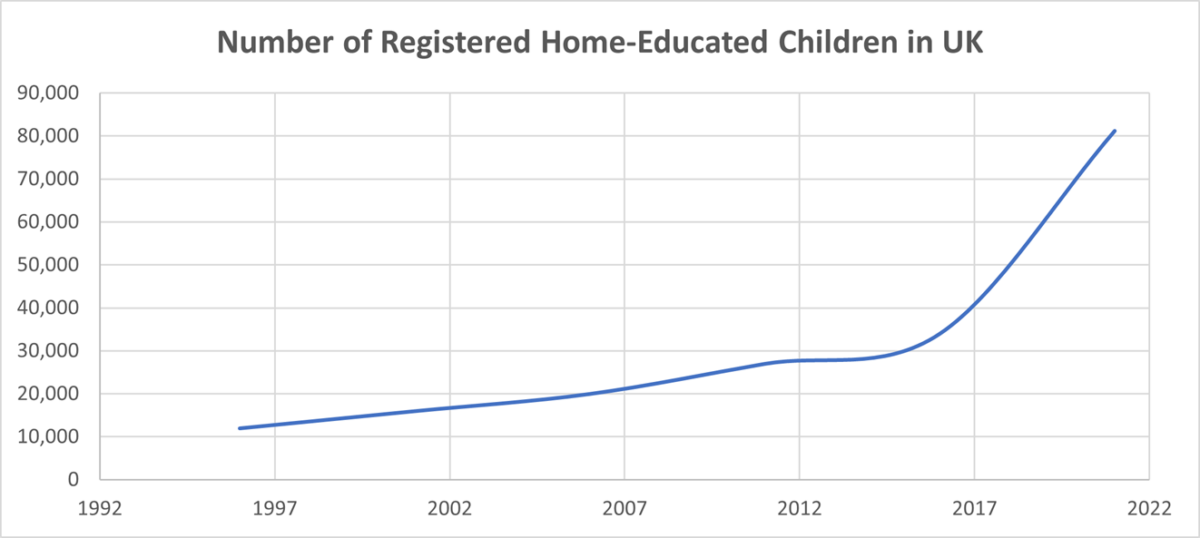Is The Rise And Rise Of Homeschooling Explained By Advances In Tech?

This is the first article in a two-part series on homeschooling. In this mini-series, I shall challenge the assertion that the reason for the meteoric growth in home education was Covid and suggest it was down to an assortment of factors; the alluring ‘pull’ of studying at home and the uncomfortable ‘push’ driving students out of the school environment. In this first article, we look at the background behind the rise in home education and the ‘pull’ factors.
Under The Radar
I was intrigued recently by the increased level of interest in home education learners applying to use Kloodle, the digital skills development platform. After a flurry of Googling, I was surprised to discover that a whopping 3.7 million young people, and rising, are currently being homeschooled in the US, almost 7% of the school-age population. Similarly, in the UK, passing under the media radar somewhat, there has been a surge in homeschooling, the popularity of which, as you can see from the graph below, shot up rapidly during the Covid-19 pandemic when schools were forced to close for several months, disrupting the education of millions of children. The number of children registering for home education in the UK has increased four-fold since 2008, although only accounts for 1% of the population of schoolchildren.

Was The Rise All Due To The Impact of Covid?
Many councils have quoted the outbreak of Covid as the principal reason for the increase in home education; it gave students an opportunity to taste a lifestyle where they were able to study from the comfort of their own home. However, despite Covid restrictions being lifted and schools re-opening, many parents have opted to commence or continue to homeschool their children and, as the graph above shows, numbers have carried on growing post-lockdown.
Although the pandemic has been a convenient excuse used by councils and governments to explain the sustained rise in home education, there are other assorted ‘push’ and ‘pull’ factors at play.
The ‘Pull’ Factors: The Benefits Of Homeschooling
The world has changed immeasurably since the days when the US author and educator John Holt first unveiled the philosophy of what he referred to as “unschooling” or “autonomous education” in the 1970s. His belief was that if you give a child the freedom to follow their own interests, allied with a rich assortment of resources, they will do the actual learning themselves. Following his methodology, homeschoolers today can, for example, develop and fine tune research skills and learn how to ‘think like a scientist’.
Also, homeschooling can boost overall well-being; Wolsey Hall Oxford’s recent survey found that 91.5% of parents believe that their child’s wellbeing has improved since they opted for home-schooling.
Historically, one of the big stumbling blocks has been that ‘home ed’ can prove difficult for parents to manage; some guardians do the teaching themselves but it’s hard to be a teacher as well as a parent. And what if the children are brighter than their parents? A popular solution to avoid this conflict is for some parents to adopt a role of being a ‘Chief Learning Officer’, where they don’t teach but instead ‘cause to learn’ through encouragement or facilitation.
This way home-ed can be ‘child-led’ so that as well as completing syllabus tasks, the children also learn about prioritisation and problem-solving. Being self-directed involves higher level skills; this fits in with a lifelong learning philosophy and self-motivation. The focus is on skill development; for example, understanding the principles of maths and language, rather than on accumulation of knowledge.
One of the big criticisms of homeschooling has been that homeschooled children are ‘out of society’ and find it hard to make relationships. In life, people need social interactions and friends. However, the landscape here has changed. There is so much more choice for extra-curricular activities outside of school nowadays and the potential for more ‘selective’ friendship groups.
Tech Revolution Is A Key Factor
The tech revolution over the past decade has facilitated teaching and learning outside of the school classroom. Methods can include the traditional approach of textbooks, study schedules, grades and tests, but home education has the scope to be innovative and there are so many tech options available now to support this.
After all, when in doubt, you can just ‘Google it’.
There is much more professional support to tap into nowadays; parents can use multiple resources and channels available to set activities and challenges for their children. From online learning platforms to an array of interactive modules and websites, designed for learners at home across all age ranges anywhere around the globe. Below is an example of resources which some of our home education learners utilise:

In the US, it is common for homeschoolers to engage in blended participation in ‘home partnerships’, through which they can attend specific face-to-face lessons on campus to help with the subjects which can be tricky to study on your own, such as languages and science. There are also middle and high schools which offer online diploma courses at an affordable cost.
One such digital solution is Kloodle, the online skills’ and character showcasing platform. The rich experience and skills’ development and enrichment from homeschooling can be recorded on Kloodle by uploading photos, videos, documents and blogs during or after each lesson or activity, tagging in the skills. Personal reflections can be catalogued about work on Maths, English or other subjects, extra-curricular activities like Drama and Music, and even skills relating to daily life, like making your own breakfast!
In the US, it is common for homeschoolers to engage in blended participation in ‘home partnerships’, through which they can attend specific face-to-face lessons on campus to help with the subjects which can be tricky to study on your own, such as languages and science. There are also middle and high schools which offer online diploma courses at an affordable cost.
This approach can also help with entrance into further education institutions. The majority of universities and colleges in the US now accept applications from homeschooled students, and the College Board recommends that homeschooled students keep detailed records and portfolios to help them with the university admission process.
Full Monty Outsourcing
Rather than going solo or blended, some families go the whole hog and subcontract lessons out to experts, such as online schools and courses, club leaders, or private tutors. These options can be expensive, with some estimates of costs making it comparable to private education.
So, in this first article we have discussed the ‘pull’ of studying at home. Next time, we’ll consider the reasons why parents want to take their children out of the school environment.
By Neil Wolstenholme, Chairman, Kloodle
FE News on the go…
Welcome to FE News on the go, the podcast that delivers exclusive articles from the world of further education straight to your ears.
We are experimenting with Artificial Intelligence to make our exclusive articles even more accessible while also automating the process for our team of project managers.
In each episode, our thought leaders and sector influencers will delve into the most pressing issues facing the FE sector, offering their insights and analysis on the latest news, trends, and developments.












Responses